High Salinity and High Temperature Stable Colloidal Silica Nanoparticles with Wettability Alteration Ability for EOR Applications
Abstract
1. Introduction
2. Experimental
2.1. Materials
| Salts | Concentration (g/L) | Salts | Concentration (g/L) |
|---|---|---|---|
| NaCl | 27.03 | MgCl2·6H2O | 11.23 |
| CaCl2·2H2O | 1.76 | Na2SO4 | 4.81 |
| Mineral, % | Berea | Bentheimer [34] | Austin Chalk |
|---|---|---|---|
| Quartz | 90.87 | 99.0 | – |
| Albite | 0.89 | – | – |
| Sanidine | 0.46 | – | – |
| Muscovite | 3.75 | – | – |
| Kaolinite | 1.92 | 0.7 | – |
| Rutile | – | 0.3 | – |
| Clinochlore | 0.97 | – | – |
| Dolomite | 1.13 | – | – |
| Calcite | – | – | 100 |
2.2. Methods
2.2.1. Synthesis of 3-(Dimethyl(3-(Trimethoxysilyl)Propyl)-Ammonio)Propane-1-Sulfonate (SBS)
2.2.2. Surface Functionalization of Silica Nanoparticles
2.2.3. Structural and Property Characterization
2.2.4. Stability Analysis of Nanoparticle Dispersions
2.2.5. Contact Angle Measurements
3. Results and Discussion
3.1. Nanoparticle Modification and Characterization
3.2. Nanoparticle Dispersion Stability
3.3. Wettability Alteration
4. Conclusions
Author Contributions
Funding
Acknowledgments
Conflicts of Interest
References
- Green, D.W.; Willhite, G.P. Enhanced Oil Recovery, 2nd ed.; SPE Textbook Series; SPE: Richardson, TX, USA, 2018; Volume 6, pp. 1–2. [Google Scholar]
- Mokheimer, E.M.A.; Hamdy, M.; Abubakar, Z.; Shakeel, M.R.; Habib, M.A.; Mahmoud, M. A comprehensive review of thermal enhanced oil recovery: Techniques Evaluation. J. Energy Resour. Technol. 2019, 141, 030801. [Google Scholar] [CrossRef]
- Davarpanah, A. Parametric study of polymer-nanoparticles-assisted injectivity performance for axisymmetric two-phase flow in EOR processes. Nanomaterials 2020, 10, 1818. [Google Scholar] [CrossRef]
- Massarweh, O.; Abushaikha, A.S. The use of surfactants in enhanced oil recovery: A review of recent advances. Energy Rep. 2020, 6, 3150–3178. [Google Scholar] [CrossRef]
- Esmaeili, A.; Patel, R.B.; Singh, B.P. Applications of Nanotechnology in Oil and Gas Industry. AIP Conf. Proc. 2011, 1414, 133–136. [Google Scholar] [CrossRef]
- Alsaba, M.T.; Al Dushaishi, M.F.; Abbas, A.K. A comprehensive review of nanoparticles applications in the oil and gas industry. J. Pet. Explor. Prod Technol. 2020, 10, 1389–1399. [Google Scholar] [CrossRef]
- Fakoya, M.F.; Shah, S.N. Emergence of nanotechnology in the oil and gas industry: Emphasis on the application of silica nanoparticles. Petroleum 2017, 3, 391–405. [Google Scholar] [CrossRef]
- Lau, H.C.; Yu, M.; Nguyen, U.P. Nanotechnology for oilfield applications: Challenges and opportunities. J. Petrol. Sci. Eng. 2017, 157, 1160–1169. [Google Scholar] [CrossRef]
- Ko, S.; Huh, C. Use of nanoparticles for oil production applications. J. Petrol. Sci. Eng. 2019, 172, 97–114. [Google Scholar] [CrossRef]
- Zhu, D.; Han, Y.; Zhang, J.; Li, X.; Feng, Y. Enhancing rheological properties of hydrophobically associative polyacrylamide aqueous solutions by hybriding with silica nanoparticles. J. Appl. Polym. Sci. 2014, 131, 40876. [Google Scholar] [CrossRef]
- Sharma, T.; Iglauer, S.; Sangwai, J.S. Silica Nanofluids in an Oilfield Polymer Polyacrylamide: Interfacial Properties, Wettability Alteration, and Applications for Chemical Enhanced Oil Recovery. Ind. Eng. Chem. Res. 2016, 55, 12387–12397. [Google Scholar] [CrossRef]
- Almahood, M.; Bai, B. The synergistic effects of NP-surfactant nanofluids in EOR applications. J. Pet. Sci. Eng. 2018, 171, 196–210. [Google Scholar] [CrossRef]
- Wu, Y.; Chen, W.; Dai, C.; Huang, Y.; Li, H.; Zhao, M.; He, L.; Jiao, B. Reducing surfactant adsorption on rock by silica nanoparticles for enhanced oil recovery. J. Pet. Sci. Eng. 2017, 153, 283–287. [Google Scholar] [CrossRef]
- Xu, D.; BBai Ziyu, M.; Qiong, Z.; Zhe, L.; Yao, L.; Hariong, W.; Jirui, H.; Wanli, K. A Novel Ultra-Low Interfacial Tension Nanofluid for Enhanced Oil Recovery in Super-Low Permeability Reservoirs. In Proceedings of the Paper SPE-192113-MS in SPE Asia Pacific Oil and Gas Conference and Exhibition, Brisbane, Australia, 23–25 October 2018. [Google Scholar] [CrossRef]
- Bayet, A.E.; Junin, R.; Samsuri, A.; Piroozian, A.; Hokmabadi, M. Impact of metal oxide nanoparticles on enhanced oil recovery from limestone media at several temperatures. Energy Fuels 2014, 28, 6255–6266. [Google Scholar]
- Maghzi, A.; Mohebbi, A.; Kharrat, R.; Ghazanfari, M.H. Pore-Scale Monitoring of Wettability Alteration by Silica Nanoparticles During Polymer Flooding to Heavy Oil in a Five-spot Glass Micromodel. Transp. Porous Med. 2011, 87, 653–664. [Google Scholar] [CrossRef]
- Al-Anssari, S.; Barifcani, A.; Wang, S.; Maxim, L.; Iglauer, S. Wettability alteration of oil-wet carbonate by silica nanofluid. J. Colloid Interface Sci. 2016, 461, 435–442. [Google Scholar] [CrossRef]
- Kanj, M.; Sakthivel, S.; Emmanuel, G. Wettability Alteration in Carbonate Reservoirs by Carbon Nanofluids. Colloids Surf. A Physicochem. Eng. Asp. 2020, 598, 124819. [Google Scholar] [CrossRef]
- Binks, B.P.; Lumsdon, S.O. Stability of oil-in-water emulsions stabilised by silica particles. Phys. Chem. Chem. Phys. 1999, 1, 3007–3016. [Google Scholar] [CrossRef]
- Chevalier, Y.; Bolzinger, M. Emulsions stabilized with solid nanoparticles: Pickering emulsions. Colloids Surf. A Physicochem. Eng. Asp. 2013, 439, 23–34. [Google Scholar] [CrossRef]
- Kim, I.; Worthen, A.J.; Lotfollahi, M.; Johnston, K.P.; DiCarlo, D.A.; Huh, C. Nanoparticle-Stabilized Emulsions for Improved Mobility Control for Adverse-mobility Waterflooding. Soc. Pet. Eng. 2016. [Google Scholar] [CrossRef]
- Arab, D.; Kantzas, A.; Bryant, S.L. Nanoparticle stabilized oil in water emulsions: A critical review. J. Pet. Sci. Eng. 2018, 163, 217–242. [Google Scholar] [CrossRef]
- Singh, R.; Misra, V. Stabilization of Zero-Valent Iron Nanoparticles: Role of Polymers and surfactants. In Handbook of Nanoparticles; Aliofkhazraei, M., Ed.; Springer: Cham, Switzerland, 2015. [Google Scholar] [CrossRef]
- Worthen, A.J.; Tran, V.; Cornell, K.A.; Truskett, T.M.; Johnston, K.P. Steric stabilization of nanoparticles with grafted low molecular weight ligands in highly concentrated brines including divalent ions. Soft Matter 2016, 12, 2025–2039. [Google Scholar] [CrossRef]
- Jang, H.; Lee, W.; Lee, J. Nanoparticle dispersion with surface-modified silica nanoparticles and its effect on the wettability alteration of carbonate rocks. Colloids Surf. A Physicochem. Eng. Asp. 2018, 554, 261–271. [Google Scholar] [CrossRef]
- Griffith, C.; Daigle, H. Manipulation of Pickering emulsion rheology using hydrophilically modified silica nanoparticles in brine. J. Colloid Int. Sci. 2018, 509, 132–139. [Google Scholar] [CrossRef] [PubMed]
- Griffith, C.; Daigle, H. A comparison of the static and dynamic stability of Pickering emulsions. Colloids Surf. A Physicochem. Eng. Asp. 2020, 586, 124256. [Google Scholar] [CrossRef]
- Jadhunandan, P.P.; Morrow, N.R. Effect of Wettability onWaterflood Recovery for Crude-Oil/Brine/Rock Systems. SPE Res. Eng. 1995, 10, 40–46. [Google Scholar] [CrossRef]
- Austad, T.; Milter, J. Spontaneous Imbibition of Water Into Low-Permeability Chalk at Different Wettabilities Using Surfactants. In Proceedings of the Paper SPE 37236 Presented at the SPE International Symposium on Oilfield Chemistry, Houston, TX, USA, 18–21 February 1997. [Google Scholar]
- Standnes, D.C.; Austad, T. Nontoxic Low-cost Amines as Wettability Alteration Chemicals in Carbonates. J. Pet. Sci. Eng. 2003, 39, 431. [Google Scholar] [CrossRef]
- Spinler, E.A.; Zornes, D.R.; Tobola, D.P.; Moradi-Araghi, A. Enhancement of Oil Recovery Using a Low Concentration of Surfactant to Improve Spontaneous and Forced Imbibition in Chalk. In Proceedings of the Paper SPE 59290 Presented at the SPE/DOE Improved Oil Recovery Symposium, Tulsa, OK, USA, 3–5 April 2000. [Google Scholar]
- Sharma, G.; Mohanty, K. Wettability Alteration in High-Temperature and High-Salinity Carbonate Reservoirs. SPE J. 2013, 18, 646–655. [Google Scholar] [CrossRef]
- Jarrahian, K.; Seiedi, O.; Sheykhan, M.; Sefti, M.V.; Ayatollahi, S. Wettability alteration of carbonate rocks by surfactants: A mechanistic study. Colloids Surf. A Physicochem. Eng. Asp. 2012, 410, 1–10. [Google Scholar] [CrossRef]
- Al-Yaseri, A.Z.; Lebedev, M.; Vogt, S.J.; Johns, M.L.; Barifcani, A.; Iglauer, S. Pore-scale analysis of formation damage in Bentheimer sandstone with in-situ NMR and micro-computed tomography experiments. J. Pet. Sci. Eng. 2015, 129, 48–57. [Google Scholar] [CrossRef]
- Estephan, Z.G.; Jaber, J.A.; Schlenoff, J.B. Zwitterion-stabilized silica nanoparticles: Toward nonstick nano. Langmuir 2010, 26, 16884–16889. [Google Scholar] [CrossRef]
- LUM GmbH. SepView User Manual; LUM GmbH: Berlin, Germany, 2016. [Google Scholar]
- Worthen, A.J.; Alzobaidi, S.; Tran, V.; Iqbal, M.; Liu, J.S.; Cornell, K.A.; Kim, I.; DiCarlo, D.A.; Bryant, S.L.; Huh, C.; et al. Design of Nanoparticles for Generation and Stabilization of CO2-in-Brine Foams with or without Added Surfactants. 2019. Available online: https://arxiv.org/abs/1811.11217v2Website (accessed on 22 February 2021).
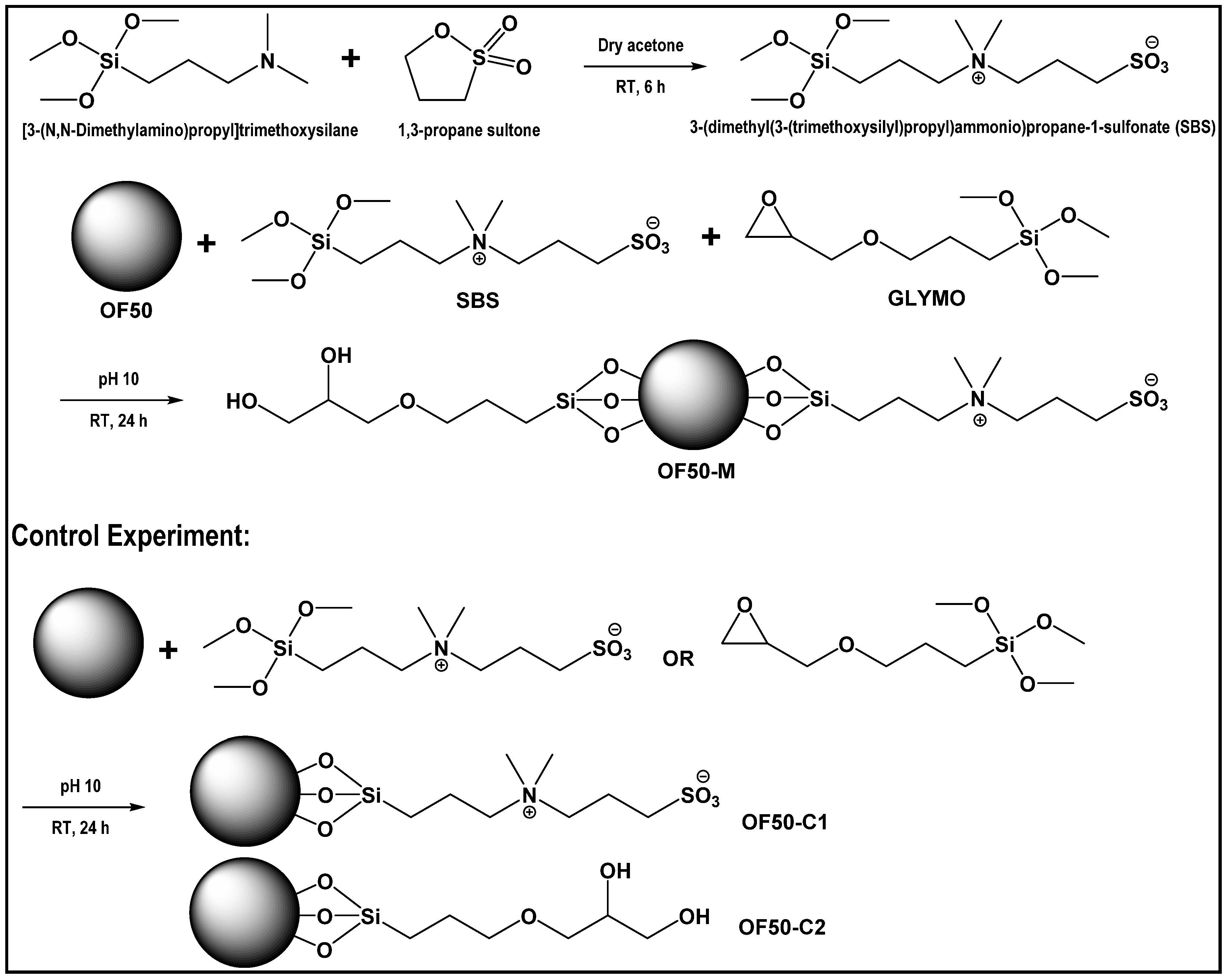

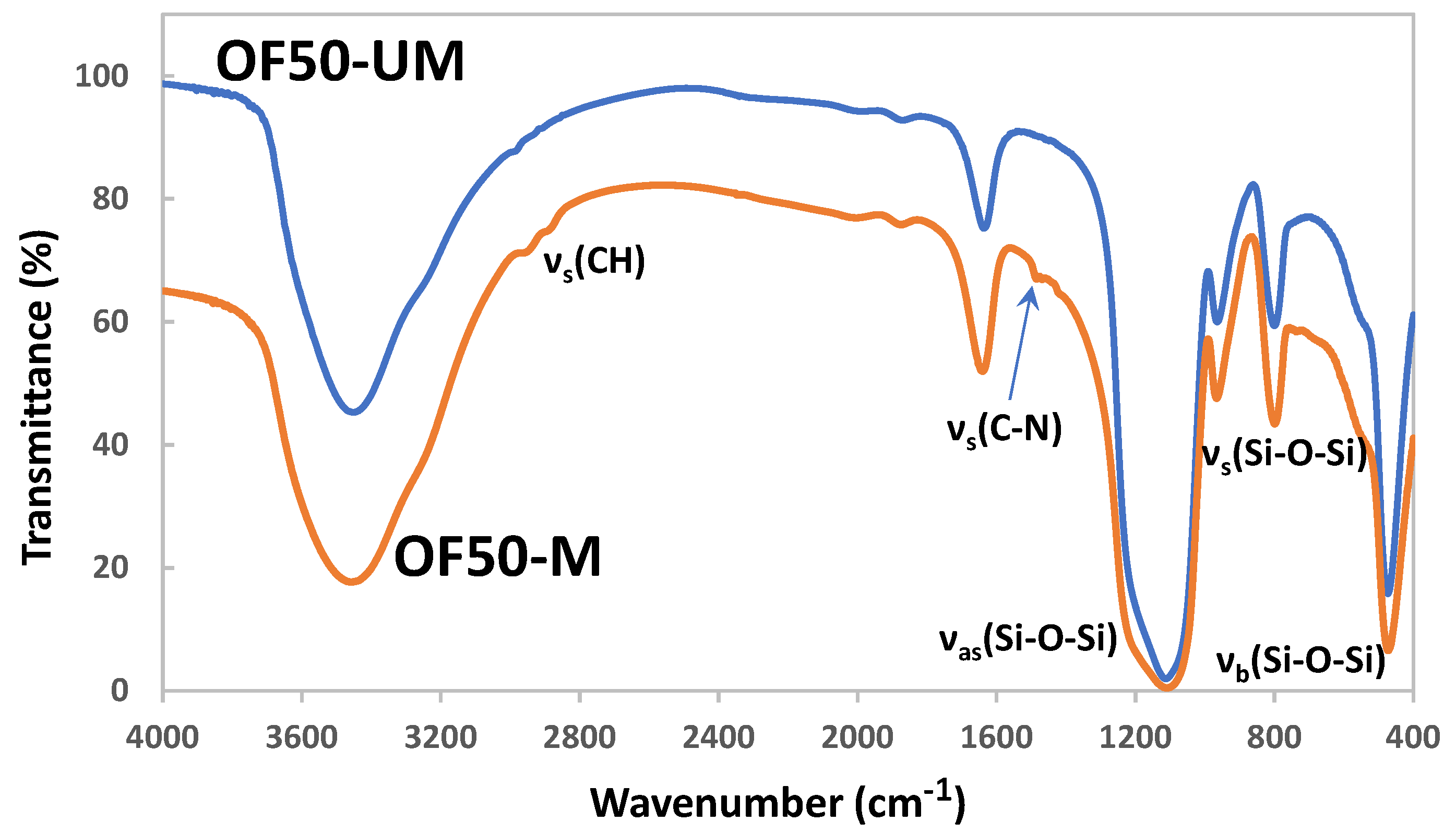

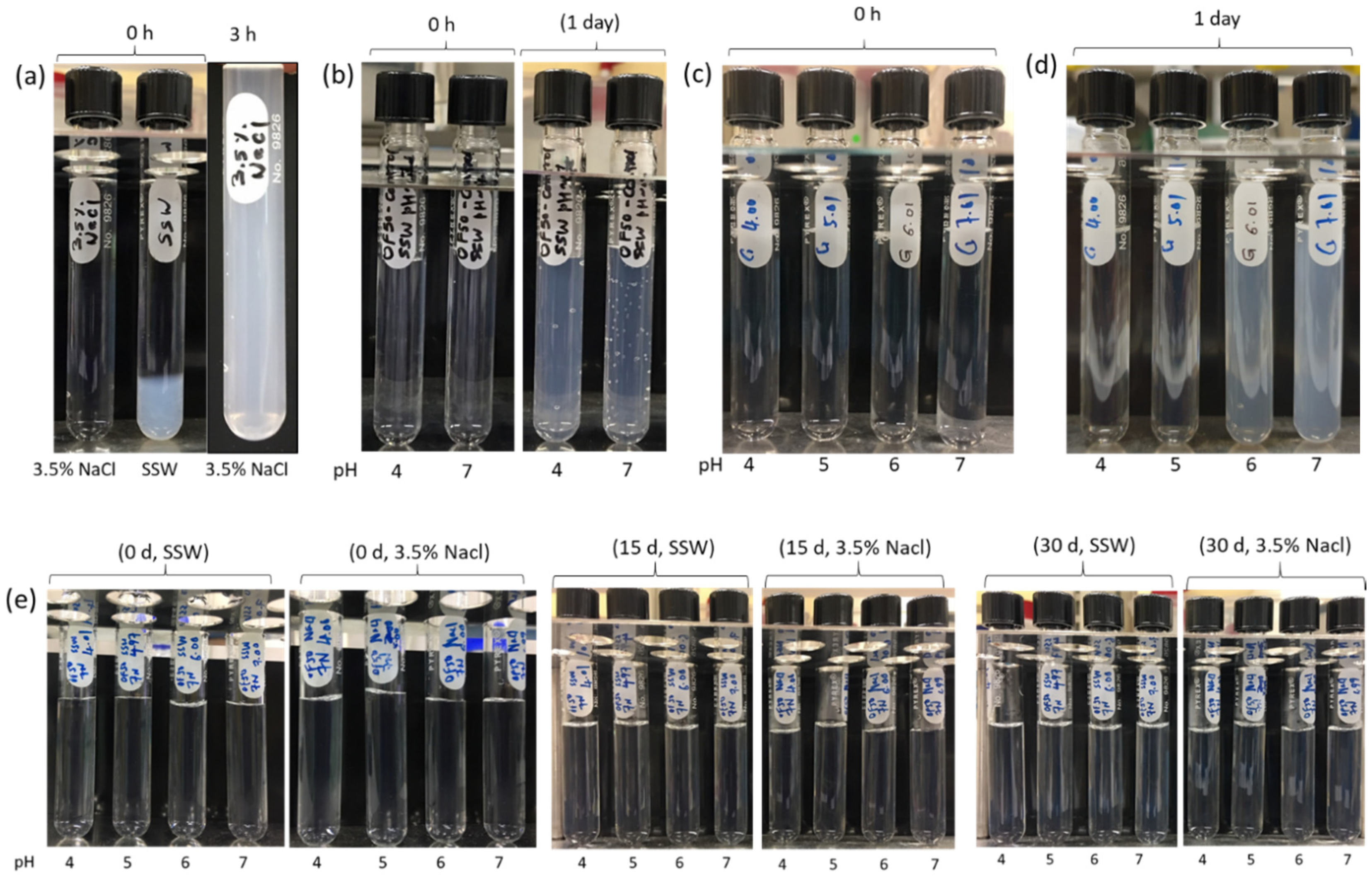
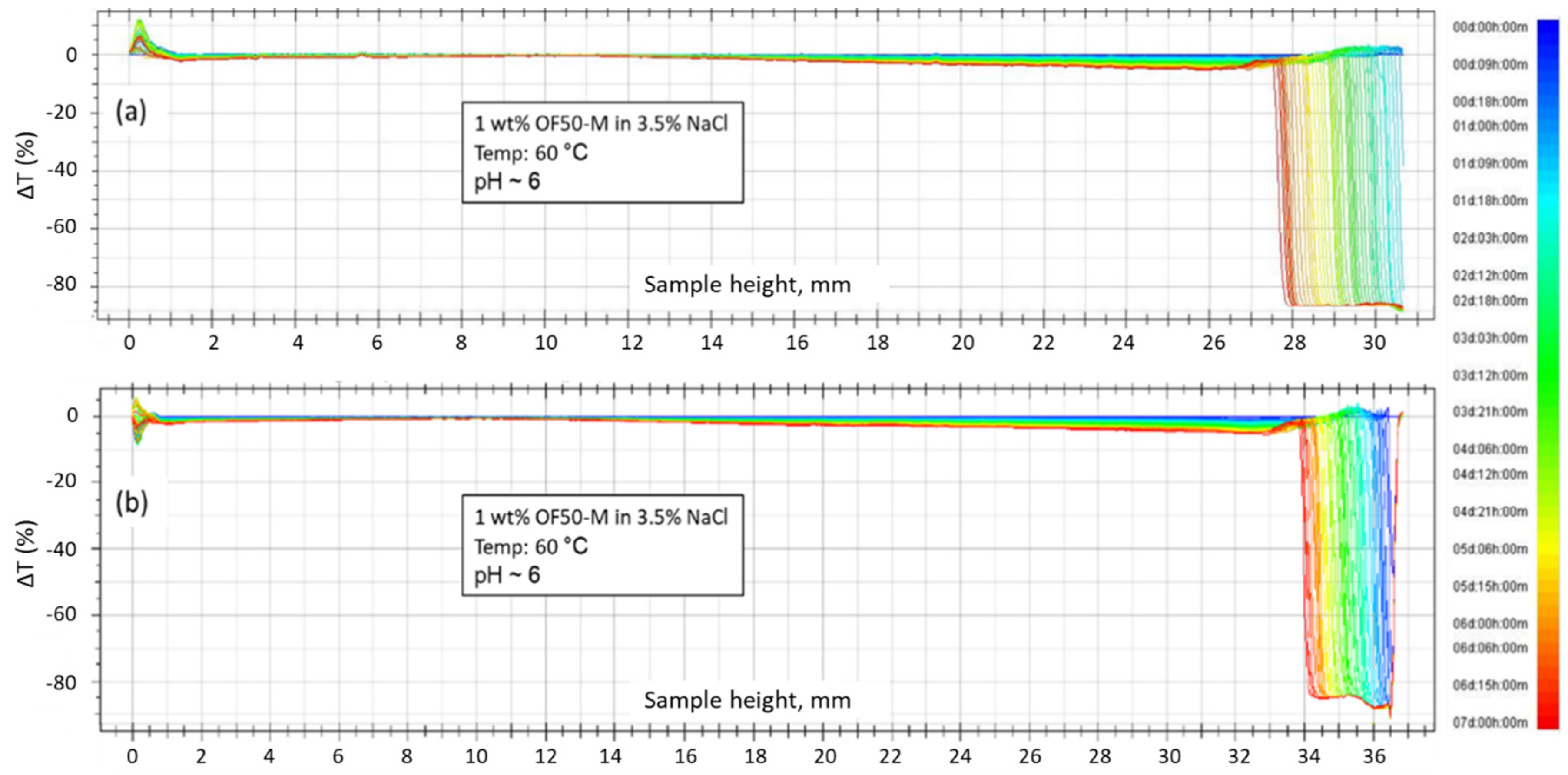
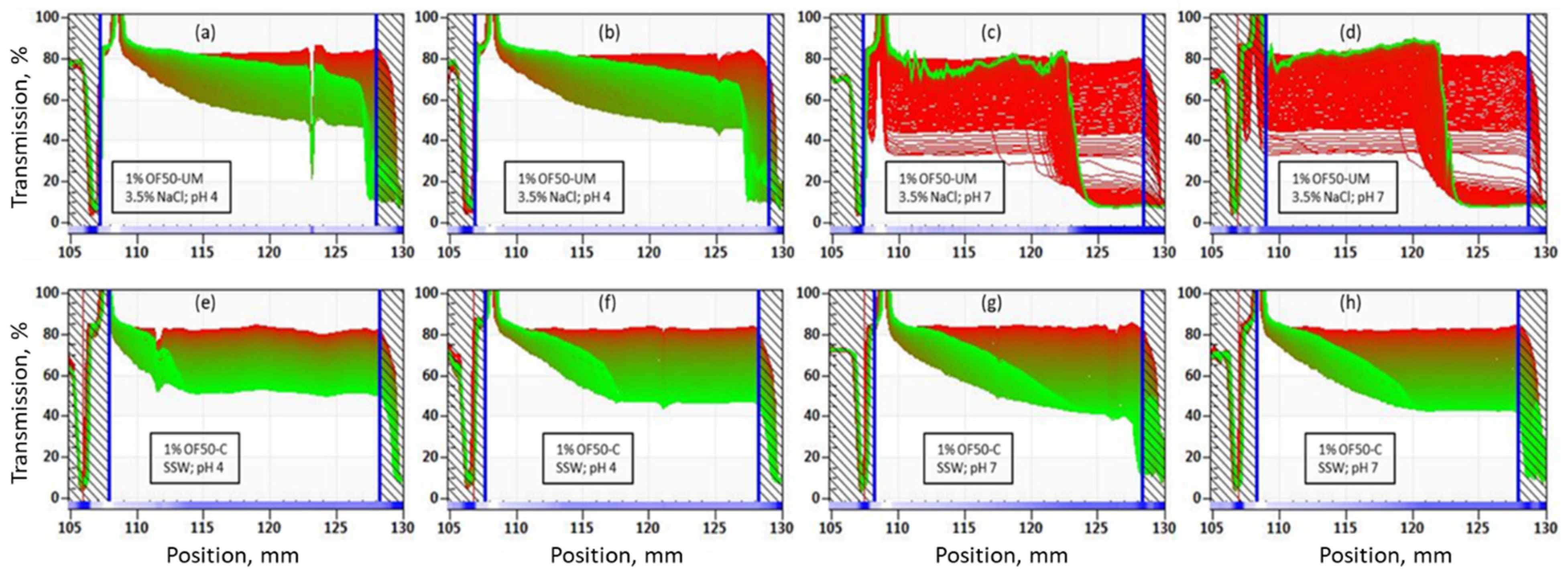
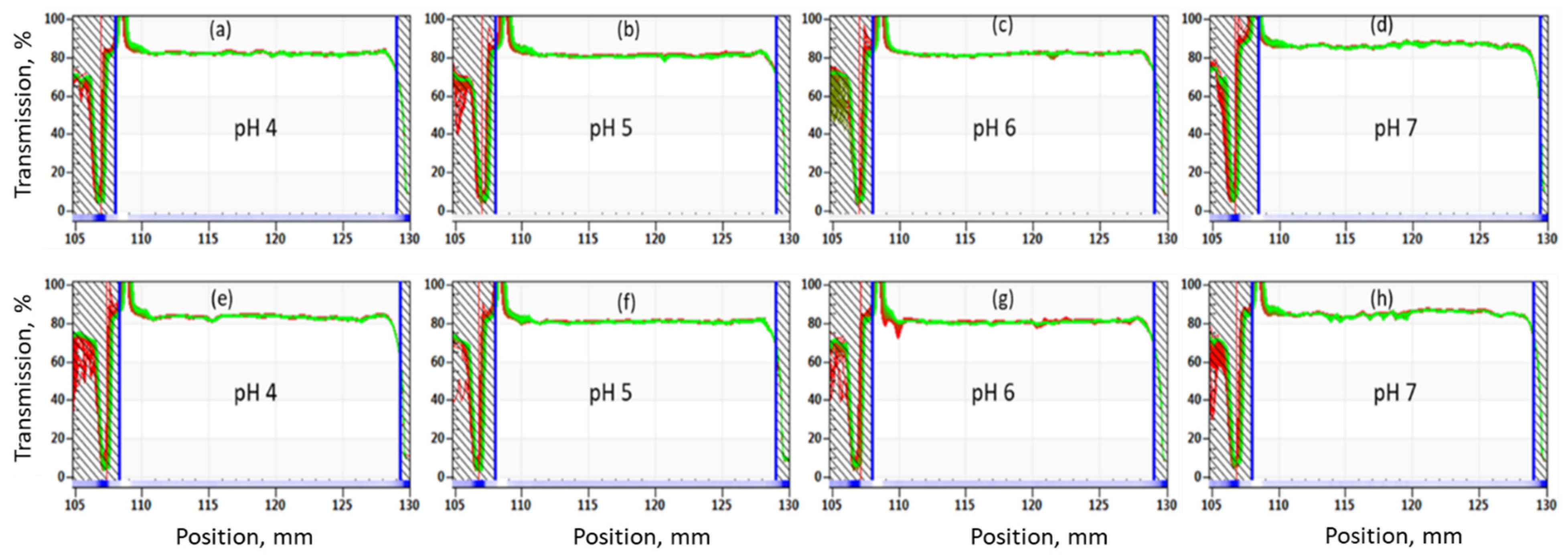


| pH | Particle Size, nm | |||||
|---|---|---|---|---|---|---|
| Fresh Sample | Treated Sample * | |||||
| SSW | 3.5% NaCl | SSW-Turbi + | SSW-ASA # | 3.5% NaCl-Turbi + | 3.5% NaCl-ASA # | |
| 4 | 22.3 ± 0.1 | 21.6 ± 0.2 | – | 22.3 ± 0.1 | – | 21.6 ± 0.1 |
| 5 | 22.5 ± 0.2 | 21.7 ± 0.1 | – | 22.7 ± 0.1 | – | 21.9 ± 0.1 |
| 6 | 22.5 ± 0.2 | 21.7 ± 0.1 | 24.2 ± 0.1 | 24.0 ± 0.1 | 23.5 ± 0.2 | 22.9 ± 0.1 |
| 7 | 22.7 ± 0.1 | 21.8 ± 0.1 | – | 24.8 ± 0.1 | – | 22.9 ± 0.1 |
| Rock Type | Contact Angle * | |
|---|---|---|
| Untreated Surface | Nanofluid Treated Surface | |
| Bentheimer | 113° | 141° |
| Berea | 110° | 131° |
| Austin Chalk | 84° | 123° |
Publisher’s Note: MDPI stays neutral with regard to jurisdictional claims in published maps and institutional affiliations. |
© 2021 by the authors. Licensee MDPI, Basel, Switzerland. This article is an open access article distributed under the terms and conditions of the Creative Commons Attribution (CC BY) license (http://creativecommons.org/licenses/by/4.0/).
Share and Cite
Hadia, N.J.; Ng, Y.H.; Stubbs, L.P.; Torsæter, O. High Salinity and High Temperature Stable Colloidal Silica Nanoparticles with Wettability Alteration Ability for EOR Applications. Nanomaterials 2021, 11, 707. https://doi.org/10.3390/nano11030707
Hadia NJ, Ng YH, Stubbs LP, Torsæter O. High Salinity and High Temperature Stable Colloidal Silica Nanoparticles with Wettability Alteration Ability for EOR Applications. Nanomaterials. 2021; 11(3):707. https://doi.org/10.3390/nano11030707
Chicago/Turabian StyleHadia, Nanji J., Yeap Hung Ng, Ludger Paul Stubbs, and Ole Torsæter. 2021. "High Salinity and High Temperature Stable Colloidal Silica Nanoparticles with Wettability Alteration Ability for EOR Applications" Nanomaterials 11, no. 3: 707. https://doi.org/10.3390/nano11030707
APA StyleHadia, N. J., Ng, Y. H., Stubbs, L. P., & Torsæter, O. (2021). High Salinity and High Temperature Stable Colloidal Silica Nanoparticles with Wettability Alteration Ability for EOR Applications. Nanomaterials, 11(3), 707. https://doi.org/10.3390/nano11030707






